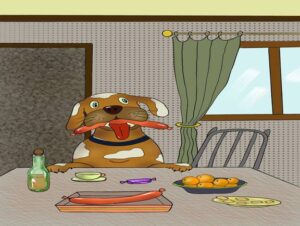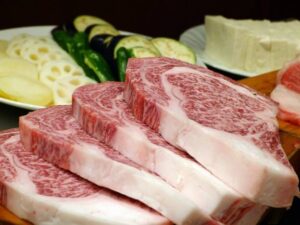Finding the right types of dog food for your furry friend is just like finding a needle from the haystack, especially when you don’t even know which type of dog food suits your puppy the best. Although it’s very exciting for the pet owners to share their adventures and companionship with their four-legged furry friends, sometimes it is nerve-racking to decide which dog food types can most meet my Dog’s nutritional requirements. It’s not just about the flavor, texture, and enticing look of the dog food type. It’s something that decides your puppy’s healthy or insalubrious lifestyle.
We will look out about the five types of dog foods and their pros and cons to avoid any kind of nerve-racking in deciding the food type for your Dog.
Types of Dog food- Full of Essential Nutrients
1-Kibble:
You might be unfamiliar with the word Kibble, but your puppy will simultaneously wag its tail with glee while someone will Futter the word Kibble in front of it.
Kibble is the first-ever commercially produced dog food type for the convenience of pet owners with all the nutrients in just one pot. The essential nutrients that guarantee the safe and sound growth of your Dog are the soul of Kibble. It’s a type of ground dog food type that is turned into round pellets form. You can serve a Kibble to your Dog after cooking. Kibble is packed with carbs, meat, fish, eggs, grains, and cereals that supply enough proteins, vitamins, and minerals.
Whether it maintains its original identity in case of shape or texture or not, you’ll always find Kibble with all the nutrients that were part of the first commercial Kibble. So, you can see the variation in its look, but it never compromises on nutritional perks.
Types of Kibble Diet:
- Extruded
- Baked
- Coated
Instead of promising a nutritionally healthy diet for the Dog, it cleanses the dog teeth to maintain the shiny white looks of canine teeth by kicking out the tarter and plaques from the Dog’s teeth.
You must shun the brands that fill up the kibble food with extra flavors, preservatives, and fillers because that might put your Dog on the bed instead of promising an active lifestyle.
Pros:
- All nutritional ingredients in one bowl
- Less bacterial risk
- Favorable price
- Fewer trips to the dentist
- Long shelf life
- Easy to preserve and simple to feed
Cons:
- Some brands compromise on quality because Kibble is cheap
- It can cause bloating rarely
- Contamination with lots of manufacturing errors
2-Canned Food:
The second most common and popular way to feed your dog is to provide them with canned dog food types. Canned dog food no longer relies on canned metal containers but is now a day packed in B.P.A. free environmentally friendly packs. It’s the opposite of kibble food and is mostly suitable for senior dogs with difficulty in chewing dry foods.
The rare option in Kibble is the strength of canned food, and that is its palatability. The variation in its taste and flavor makes it more enticing for finicky dogs to ensure regular and healthy eating trips. Some finicky dogs don’t like to eat dry food, so you can try wet, flaked, and stew canned food formula to appeal to the Dog’s hunger.
Undoubtedly canned types of dog food help to keep the dogs hydrated. It’s not rare for dogs to hate or avoid water which makes them prone to dehydration. Canned dog food is the best option for the pet owner to keep their furry friend hydrated as it can meet 70% of the Dog’s water requirement compared to the 10% by the traditional dry Kibble.
A hydrated dog body ensures better digestion, which promises nutrient absorption, fat burning, and high calories.
Best Canned foods:
- Wellness stew
- Farmer’s Dog fresh
- Olie fresh
- Weruva wet dog food
- etc.
Pros:
- More palatability
- Ward off dehydration
- Higher shelf life
- Easily available in supermarkets
Cons:
- Not suitable for dog’s dental health
- Expensive
3-Semi-solid or Semi-moist:
You may see semi-solid or semi-moist dog foods in the form of chopped pork, burgers, and different meaty foods. Very often, it also comes in the form of a soft pallet packed in sachets.
Semi-moist dog food types are least nutritional, full of flavors, with extra sugar, salts, and artificial coloring. As a least nutritional food, it has no guarantee for a dog’s healthy life but can just enhance palatability. To Shun, such food as a casual diet is a gentle approach, but changing your dog flavor rarely is not dangerous. However, it can be very enticing for your furry pals, but it’s not as nutritional as its counterparts. You can offer occasional treats to fresh up your Dog, but no more than this.
But it can keep your Dog hydrated as it contains 60-65% of moisture in it, and you must feed it to your Dog within 3 to 5 days after opening because of its lower shelf life.
Best Semi-moist Dog Food Types:
- Natural Balance L.I.D. limited ingredient
- Cesar filler in gravy beef flavor
- Wellness core grain
- Purina
- etc.
Pros:
- Palatability
- Adequate moisture content
Cons:
- Expensive
- Unhealthy because of artificial flavor and coloring
- Less shelf life after opening
- Fewer calories
4-Home-cooked:
Some bossy yet cautious dog owners try to take full control of their Dog food types, and they are more interested in being familiar with what and how much their dog is eating, so they prefer to use Home-cooked types of dog food. Although its time consuming and hectic task, it is worths the peace of mind. If you are interested in being a chef for your Dog, you must have a sound knowledge of dog nutrition to make sure that either the food cooked by you is sufficient to meet your Dog’s nutritional requirements or not.
A blend of Spinach, Zucchini, Peas, Carrot, Ground Chicken, and brown rice can be enlisted in a best homed cooked food. Instead of this, you can add eggs, oatmeal, and grains, or some other foods edible for the dogs.
The home-cooked types of dog food are enriched with carbohydrates, fats, minerals, fatty acids, calcium, proteins, and vitamins.
Pros:
- Free from contamination and seasoning-free
- Almost all essential nutrients
- Choice of added ingredients
Cons:
- Time taking
- Inconvenient
- Most dog owners don’t know which ingredient suits the Dog’s health or not
- Too much or less nutrition
- Can be expensive
5-Raw food:
Raw food is the most promising dog food types formula to help your Dog get a food full of complete nutrition which is safe to nibble, full of energy, palatability, and flavor. No doubt it’s natural and the safest food recommended by pet owners as well as by veterinarians.
Instead of getting rid of a hassle for cooking foods, your Dog can intake the ingredients and enjoy its perks without any change in its composition that mostly happens in the case of cooked food. You can feel a visible change in your furry friend’s body mass, activeness, and stamina level for all age groups.
Organ meat, bones, muscle meat, vegetables, fruits, and yogurt can be the most recommended raw foods for dogs. Raw meat can provide the dogs with phosphorous and calcium to give them a regal appearance with strong muscles. Dogs with pancreatic issues, weak immune systems, and cancer should not be allowed to nibble raw foods.
Pros:
- Full of nutrition
- Original without any change of ingredient composition
- Build muscles and strengthen bones
- Safe and free from seasoning
- Free from contamination
Cons:
- Meticulous care in sanitation and handling of raw food
- Not safe for the dogs with some serious health issues
Conclusion:
You may come across a variety of Dog food types mentioned above from brand to brand. So, it’s a must for you to shun the brands with extra flavoring, seasoning, and preservatives. Although not even a single type of dog food type is full of pros and free of cons, you can rely more on raw food, home-cooked food, and Kibble. Using semi-moist food with tons of flavoring agents can be fatal. It’s better to take advice from pet owners of the same breed or veterinarian. The Bottom line is, it doesn’t matter which type of food your Dog is nibbling. What matters the most is you shouldn’t compromise with your Dog’s health.


